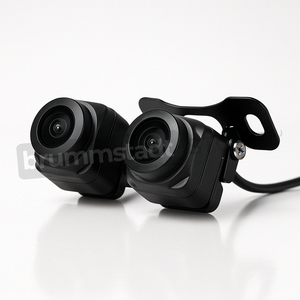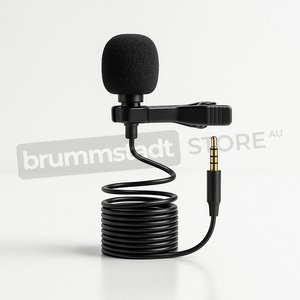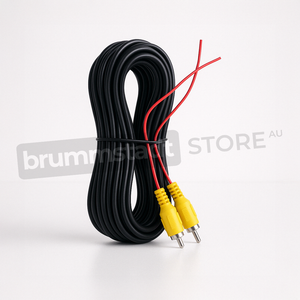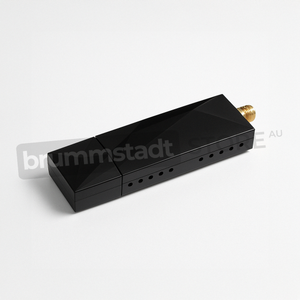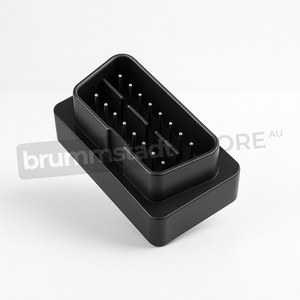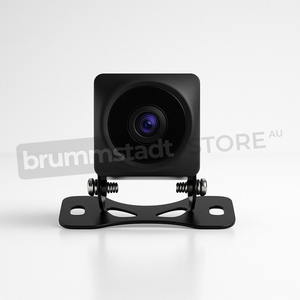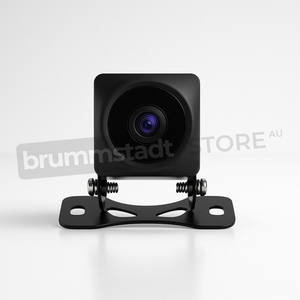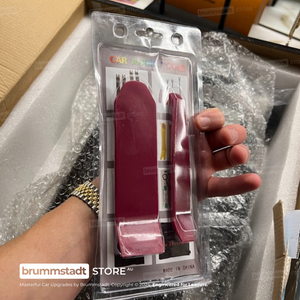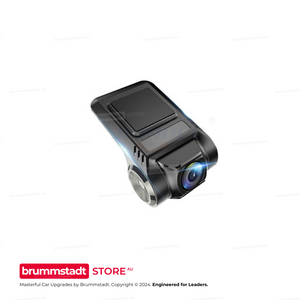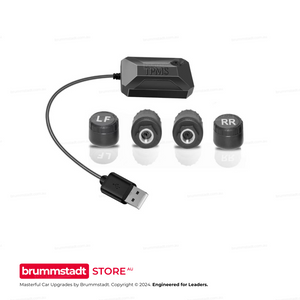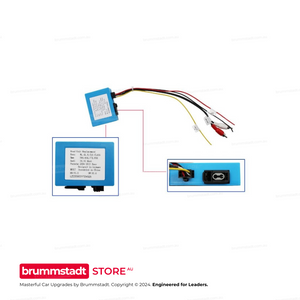Frequently Asked Questions
Everything you need to know about this head unit
Connect the single RCA cable with the yellow plug (included in your package) to extend your Bluetooth signal. This cable doubles as both a camera input AND a Bluetooth/WiFi antenna extension. The two small blue wires attached are antenna boosters that significantly improve connection stability. This simple connection takes 30 seconds and resolves 90% of Bluetooth issues. Make sure it's firmly connected even if you're not using a rear camera.
Try these proven solutions:
1. Quick Fix: Settings → Apps → Z-Link → Disable → Enable → Open (repeat each use)
2. Check Cables: Use the data/charge USB cable (not charge-only)
3. Bluetooth Setting: Disconnect all other Bluetooth connections - CarPlay needs exclusive access
4. Factory Reset Z-Link: Find the pink 'RESET' app, restart, reconnect Bluetooth, then try Z-Link
5. Sound Issues: Switch audio source to 'AUX' or 'USB/AUX' in your vehicle menu
Most issues are resolved with step 1 or 3!
The processor differs between models: The 2/32GB has a 4-Core processor, while 4/64GB and 8/128GB models feature the powerful 8-Core Cortex-A55 processor. Combined with RAM differences: The 2/32GB model with its 4-Core processor and limited RAM may experience slowdowns with heavy multitasking. The 4/64GB with 8-Core provides smooth performance for most users - no lag, seamless app switching, and enough storage for maps and music. The 8/128GB with 8-Core offers maximum performance with its generous RAM allowing unlimited multitasking and massive storage for extensive media libraries. Think of RAM like your desk space - more RAM means you can have more apps open simultaneously without slowing down.
Absolutely normal! These head units are complete replacement systems with their own GPS antenna, microphone, and Bluetooth module. Your factory connectors for these features won't be needed anymore. The important connections are: main power harness, speaker outputs, and the yellow RCA cable (even if not using a camera - it extends Bluetooth range). Any leftover factory plugs can be safely tucked away. If you're unsure about any connection, our support team is here 7 days a week.
Z-Link updates are handled through system firmware updates. Go to Settings → System → System Update. If an update is available, download it to a USB drive (FAT32 format) and install. Important: Never download Z-Link APKs from unofficial sources - they won't work and may cause issues. If you're having compatibility issues with newer iOS versions, the disable/enable workaround (Settings → Apps → Z-Link) usually resolves them while waiting for official updates.
Consider your usage:
• 2/32GB (4-Core): Budget option - fine for basic use, but may lag with multiple apps due to 4-Core processor and limited RAM
• 4/64GB (8-Core): Sweet spot - smooth Android Auto/CarPlay, multitasking, and ample storage
• 8/128GB (8-Core): Premium choice - unlimited multitasking, massive storage, future-proof for years
Most customers choose 4/64GB for the perfect balance of performance and value. The extra RAM makes a huge difference in daily smoothness!
The yellow RCA cable's blue antenna wires also boost WiFi signal! Make sure this cable is connected. Additionally, try these tips: Position the blue antenna wires away from metal surfaces, check that your phone's hotspot is set to 2.4GHz (not 5GHz) for better range, and ensure the head unit's WiFi sleep policy is set to 'Never' in Settings → WiFi → Advanced. For best performance with wireless CarPlay, keep your phone within 1-2 meters of the head unit.
Go to Settings → Sound → Equalizer and adjust to your preference. For more volume, increase the 'Loudness' setting. The 4/64GB and 8/128GB models have superior audio chips that provide cleaner, louder sound. If you have an amplifier, use the RCA outputs for best quality. Also check Settings → Factory Settings (password usually 126) → Audio settings for additional gain controls. Remember: higher-spec models (4GB+) include premium audio components for noticeably better sound.
Yes! Most vehicles work instantly. If not, use the steering wheel learning app: tap the steering wheel icon, press each button on your wheel, and assign functions. For newer vehicles with CANbus, we provide CANbus modules for automatic setup. Some vehicles may need the Key1/Key2 wires connected (usually included in our harness). If you're having trouble, let us know your exact vehicle model and we'll provide specific instructions.
We offer a 30-day return policy. If it doesn't fit or there's a compatibility issue, we'll work with you to resolve it. If you change your mind, a 20% restocking fee applies. Our team verifies compatibility before shipping to minimize issues. We provide installation support 7 days a week to help resolve any problems. With our 3-year warranty and Australian-based support, you can purchase with confidence. Full details in our Refund Policy.
Historical Context and Evolution of the Mazda BT-50:
1. Mazda B-Series lineage (1961-2006):
The BT-50 traces its roots to Mazda's renowned B-Series pickups, vehicles that found favor across various global markets since the early 1960s. The Mazda B-Series, initially produced in Japan and branded as Mazda Proceed domestically, gradually gained international recognition throughout the decades due to its straightforward reliability and robust performance. Durable, versatile, and utilitarian, the small to medium-sized pickups became integral companions for tradesmen, farmers, businesses, and recreational enthusiasts looking for capable yet nimble truck solutions. Notably, from the late 1970s onwards, these Mazda trucks were exported and earned acclaim under several names, including the Mazda Bravo in some Australian markets and the Mazda Bounty in New Zealand.
2. Mazda BT-50 First Generation (UN; 2006-2011):
The emergence of the actual BT-50 nameplate in 2006 significantly expanded Mazda’s stance in international pickup markets. Built in collaboration with Ford and sharing underpinnings closely related to the Ford Ranger PJ and PK models, Mazda’s first generation BT-50 (model code UN) featured rugged construction, strong diesel engines, impressive towing capabilities, and commendable off-road handling. Affordable and practical, with commendable performance both on-road and off, this version resonated particularly strongly within the Australian, Asian, and South American markets, where its balance of economy, reliability, and capability made it a solid choice both commercially and privately.
3. Mazda BT-50 Second Generation (UP/UR; 2011-2020):
With the UP/UR variant beginning in 2011, Mazda shifted its pickup's identity towards a comfortable yet still robust lifestyle-oriented direction. Strong mechanical underpinnings, this generation maintained its relationship with the Ford Ranger PX series—Mazda and Ford jointly developed this advanced pickup platform, making the BT-50 second generation a capable, technically sophisticated, and ruggedly dependable vehicle.
This generation significantly redefined the aesthetics, embracing Mazda’s Kodo design ethos, ensuring a more refined and contemporary appearance. Initially, some purists preferred the traditional rugged truck styling; however, over time, the enhanced comfort, improved interiors, quieter cabins, and smoother driving dynamics greatly increased appreciation among a broader audience. Notably reliable engine choices included robust turbo-diesel units—the durable 3.2-liter inline five-cylinder diesel option particularly gaining praise for ample torque, confident towing performance, and consistent reliability. Moreover, the refined suspension improved road manners without compromising off-road toughness.
Inside, the vehicle offered enhanced comfort and convenience, introducing safety technology advances throughout the years—including stability control, side curtain airbags, rear-view camera integration, and increasingly sophisticated infotainment options. This second-generation BT-50, though built to meet the heavy demands of rigorous working environments, progressively positioned itself comfortably as a vehicle suitable for day-to-day family use as well.
Enhancing Technology and Integrated Experiences:
With technological advancements reshaping driving expectations, embracing contemporary infotainment technology has become central to vehicle enjoyment and convenience. Within this context, Brummstadt offers a premium aftermarket head unit explicitly developed to seamlessly integrate into the Mazda BT-50’s dashboard design from 2011 to 2020. This product addresses the growing needs for structured smartphone connectivity, intuitive navigation, entertainment, and overall ease-of-use functionality that complements BT-50 owners' daily driving and lifestyle routines.
Specifically engineered to match the BT-50’s original dashboard aesthetic, the head unit equips owners with both wired and wireless Apple CarPlay as well as Android Auto capabilities, centralizing multimedia functionality, smartphone-based communications, and advanced navigational assistance on a high-resolution, responsive touchscreen panel. Compatible with widely used navigation applications such as Google Maps, Apple Maps, and Waze, this integration significantly simplifies route planning and direction-following: imagine spending an evening dining with loved ones when spontaneously deciding to drive to a friend's place afterward. With the destination pre-selected quickly via a personal smartphone, the map instantly transitions onto the head unit’s prominently positioned screen. This effortless transition demonstrates real-world convenience that reduces stress and streamlines journeys, providing clarity for occupants even in unfamiliar or dimly lit environments.
Moreover, this Brummstadt infotainment upgrade includes an optional high-quality 1080p HD camera suite, supporting both front and rear-facing views with recording capabilities. Such enhancement helps owners obtain important visual documentation of the vehicle surroundings, improving driving clarity, aiding parking maneuvers, and providing peace of mind in the event of unforeseen events or accidents.
For the Mazda BT-50, advanced infotainment integration also brings the potential for novel in-vehicle entertainment experiences, particularly valuable on longer journeys. The Brummstadt head unit allows joysticks or gamepads directly via USB ports, providing occupants—particularly younger family members—interactive gaming methods displayed on the sizable touchscreen. Additionally, powerful voice-controlled operations become available through integration of popular smart voice assistants like Siri or Google Assistant, allowing quick and safe control of music, navigation commands, and even integrated smart-home devices. Imagine simply saying, "Hey Siri, turn on the porch lights," while nearing home at night, and witnessing the lights illuminate on arrival—highlighting both the convenience and potential to significantly simplify routines.
Benefits and Driving Satisfaction with Technological Integration:
Mazda BT-50’s 2011-2020 generation vehicles established a powerful blend of rugged reliability, commendable capability, comfortable refinement, and practicality, making them outstanding everyday and working vehicles. Already strong performers, their value climbs notably with an intelligently integrated infotainment upgrade, addressing modern connectivity, navigation capability, and enjoyable driving comforts integral to contemporary lifestyle expectations.
A carefully integrated product like Brummstadt’s advanced head unit succeeds in meeting practical daily-driving demands as well as adding substantial interactive experiences beneficial on recreational journeys. These enhancements provide measurable convenience, connectivity, entertainment quality, and peace of mind—significantly elevating the pleasure and satisfaction that owners experience from their already commendable Mazda pickups.
In summary, understanding Mazda BT-50’s evolution reveals a persistent dedication to practical functionality, reliability, and quality. Its historical progression from straightforward utility to mature sophistication illustrates Mazda’s sensitivity towards evolving customer preferences and uses. Complementing these vehicles with thoughtfully integrated infotainment and safety technology facilitates both pragmatic daily life improvements and genuinely enjoyable user experiences, fortifying the vehicle’s reputation and solidifying owner appreciation well into the future.
















